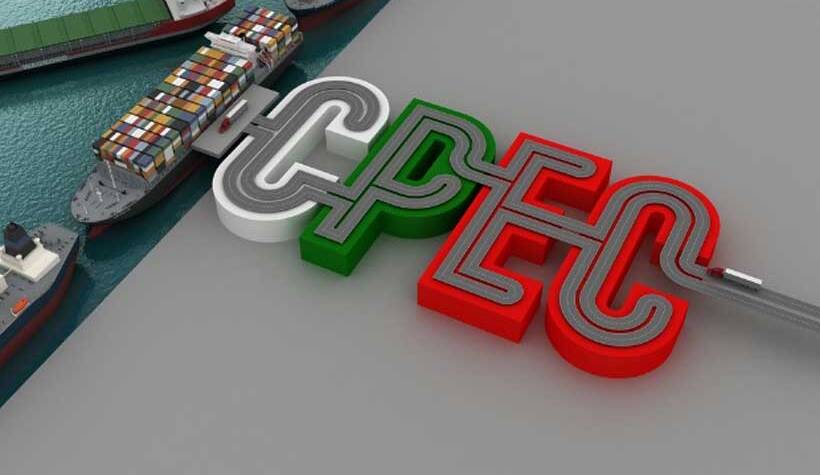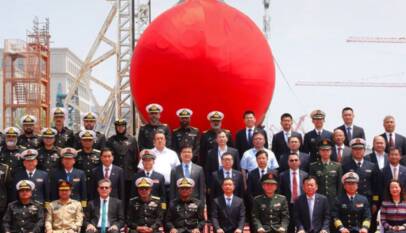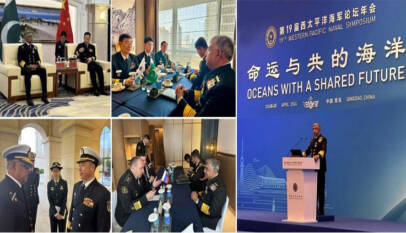CPEC set to maintain gamechanger status in 2024, analyst says
The article, authored by Yasir Habib Khan, President of the Institute of International Relations and Media Research (IIRMR), discusses the transformative impact of the China-Pakistan Economic Corridor (CPEC) on Pakistan’s development in 2024.The Mainline-I (ML-I) project, set to commence, represents a significant leap in rail infrastructure, with plans to address infrastructure damage and extend rail tracks to meet future demands. CPEC’s influence extends beyond transportation, with initiatives in agriculture, education, healthcare, and poverty reduction. Special Economic Zones (SEZs) highlight the commitment to industrial growth, while Gwadar’s development as a regional hub underscores infrastructure enhancements and energy projects. The Gwadar International Airport, scheduled for inauguration, symbolizes the enduring partnership between China and Pakistan. Progress in transportation infrastructure, such as the Zhob-Quetta and Khuzdar-Basima road projects, reflects improved connectivity. Socioeconomic development initiatives include agricultural technology collaboration, education system enhancements, healthcare infrastructure improvements, and vocational training programs. The article emphasizes CPEC’s comprehensive approach to fostering sustainable growth, economic prosperity, and regional integration, with a focus on anticipated developments in 2024. Special Economic Zones, energy projects, and infrastructure enhancements in Gwadar contribute to Pakistan’s emergence as a key regional player.
As the year 2024 unfolds, the China-Pakistan Economic Corridor emerges as a key driver of transformative and all-round developments in Pakistan, with several groundbreaking initiatives poised to redefine a fresh face of progress and growth.
A highlight among these is the Mainline-I (ML-I) project, set to commence early in the year, representing a monumental leap in rail infrastructure. The two-phase plan involves laying a 930-km rail track from Karachi to Multan in the first phase, addressing infrastructure damage causd by the 2022 floods. Subsequently, the second phase extends the rail track from Multan to Peshawar, aligning with future demands.
CPEC’s influence extends to socioeconomic development, with initiatives in agriculture, education, healthcare, and poverty reduction. The establishment of under-construction Special Economic Zones (SEZs) further underlines the commitment to diverse industrial growth. Gwadar’s development, including infrastructure enhancements and energy projects, positions it as a key regional hub. As CPEC continues to shape Pakistan’s future, the collective impact of these initiatives reflects a comprehensive approach towards fostering sustainable growth, economic prosperity, and regional integration
In parallel, the inauguration of the Gwadar International Airport is expected in mid-2024. Spanning 4,300 acres, this airport boasts a runway accommodating large aircraft and a modern terminal building. With an estimated cost of $246 million, its completion will not only mark a new era for air travel in Pakistan but it also solidifies the enduring partnership between China and Pakistan.
Transport Infrastructure
In 2024, the China-Pakistan Economic Corridor (CPEC) is set to achieve notable milestones other than the groundbreaking of ML-1 in the realm of transportation infrastructure, contributing to enhanced connectivity and economic development. The completion or significant progress of several key projects is anticipated to reshape the region’s transportation landscape. The Zhob-Quetta (Kuchlak) (N-50) project, spanning 305 km, promises to improve connectivity between Zhob and Quetta, facilitating smoother movement of goods and people. Likewise, the Khuzdar-Basima Road (N-30), covering a distance of 106 km, is expected to enhance accessibility and connectivity in the Khuzdar region. The Hoshab-Awaran Road Section (M-8) project, stretching over 146 km, will contribute to the development of infrastructure in the Awaran district, fostering economic growth.
Additionally, the KKH Alternate Route Shandur-Chitral Road, spanning 153 km, holds the promise of improved connectivity and accessibility to the picturesque Chitral region. The completion or progress of the Nokundi-Mashkhel Road, covering 103 km, will bolster transportation links in the Nokundi and Mashkhel areas, promoting economic activities in these regions. As these projects advance, they not only signify improvements in transportation but also reflect the broader impact of CPEC in fostering economic development, regional integration, and improved connectivity throughout Pakistan.
Socioeconomic Development
The China-Pakistan Economic Corridor (CPEC) has played a pivotal role in propelling social and economic development in Pakistan, and there are high expectations for significant advancements in various ongoing projects in the year 2024. One noteworthy endeavor is the China-Pakistan Joint Agricultural Technology Laboratory, poised to make strides in enhancing agricultural practices through collaborative research. The provision of agricultural equipment and tools is anticipated to witness notable progress, contributing to increased productivity in the agricultural sector.
The commitment to advancing the country’s academic infrastructure is exemplified by the establishment of smart classrooms for higher education. Furthermore, the targeted maintenance and renovation efforts focusing on 50 schools in newly merged districts are expected to make substantial headway in improving educational facilities. The deployment of solar-powered lighting equipment aligns with sustainable energy goals, while the overseas student scholarship program signals continued dedication to human capital development.
In the healthcare sector, the expected progress in providing medical equipment and materials, along with the ongoing Gwadar hospital project, underscores the focus on healthcare improvements. Initiatives like the Brightness Journey in Pakistan, coupled with projects addressing drinking water equipment and the Gwadar Desalination Plant, are poised to meet crucial needs of the population. Lastly, the Gwadar Vocational and Technical Project aims to equip the local workforce with essential skills for the evolving job market. Together, these initiatives under CPEC reflect a comprehensive approach to fostering social progress and economic prosperity in Pakistan, with a focus on anticipated developments in the year 2024.
In 2024, the CPEC is poised to initiate a range of projects, furthering its commitment to comprehensive development in Pakistan. Among these ventures, the China-Pakistan Joint Agricultural Demonstrations stand out, signalling advancements in agricultural practices through collaborative showcases. The Bacterial Grass (JunCao) Technology Training and Promotion Project aims to disseminate innovative agricultural techniques, contributing to sustainable farming methods. The Pakistan Agricultural Vocational Training initiative is set to equip individuals with the skills necessary for a thriving agricultural sector.
Moreover, the provision of teaching equipment for primary and secondary schools underscores a dedication to enhancing the education system. The establishment of burn centres reflects a focus on healthcare infrastructure, addressing critical needs in emergency medical services. The China-Pak Joint Telemedicine Network and the Medical Emergency Center in Balochistan represent significant strides in healthcare accessibility and emergency response capabilities. The Rural Poverty Reduction Joint Research Project highlights efforts to uplift marginalized communities through targeted research and interventions
The Cooperative Project with the Pak-Austria Fachhochschule Institute of Applied Sciences and Technology exemplifies international collaboration for educational advancement, fostering expertise and knowledge exchange. Lastly, the Punjab-Tianjin University of Technology Project is expected to contribute to technological innovation and academic excellence. These diverse projects collectively showcase CPEC’s commitment to fostering sustainable development, improving healthcare services, elevating education standards, and addressing key socio-economic challenges in Pakistan.
Special Economic Zones
In 2024, substantial progress is anticipated in the development of several under-construction Special Economic Zones (SEZs) under the China-Pakistan Economic Corridor (CPEC). These zones are poised to play a pivotal role in the economic growth of the respective regions. The Rashakai Special Economic Zone, located in Khyber Pakhtunkhwa near Peshawar, is expected to become a hub for various industries, including processing and manufacturing, home appliance, pharmaceuticals, home building materials, automobile and parts, agriculture and horticulture, wholesale market/ specialty mills. Similarly, the Allama Iqbal Industrial City in Faisalabad is set to house textile, packaging, automobiles, building materials, pharmaceuticals, food processing, chemical and paints, electrical and electronic, and engineering industries.
The Dhabeji Special Economic Zone in Thatta, Sindh, will contribute to the development of warehousing, building material, steel foundries, consumer electronic engineering, chemical and pharmaceuticals, light engineering, automative and auto parts. Meanwhile, the Bostan Special Economic Zone in the Pishin district is poised to foster growth in fruit processing, agriculture machinery, pharmaceuticals, motorbikes assembly, chromite, ceramic industries, ice and cold storage, electric appliance and halal food industry. These zones signify a strategic effort to diversify the industrial landscape of Pakistan, promoting sectors ranging from agriculture and textiles to pharmaceuticals and construction. The development of these SEZs is a testament to CPEC’s commitment to regional economic integration, job creation, and fostering a conducive environment for diverse industries to thrive.
Gwadar Development
Under the China-Pakistan Economic Corridor (CPEC), Gwadar is undergoing a significant transformation through various uplift programmes aimed at enhancing the city’s infrastructure and facilitating sustainable development. Significant advancements in the growth of Gwadar are expected in 2024. The ongoing construction of necessary facilities for fresh water treatment, water supply, and distribution underscores a commitment to addressing essential needs, ensuring a reliable and sufficient water supply for the growing city. As part of this initiative, the Pak-China Friendship Hospital is a key project that will contribute to the healthcare sector in Gwadar, providing accessible and quality medical services to the local population.
Simultaneously, the 300 MW Coal-Fired Power Project in Gwadar is a crucial component to meet the region’s energy demands, promoting industrial growth and economic activities. To overcome water scarcity challenges, the 1.2 MGD and 5 MGD Desalination Plants in Gwadar are being developed, offering sustainable solutions for freshwater supply. These projects not only address immediate water needs but also lay the foundation for long-term resilience against water shortages. Collectively, these initiatives reflect the comprehensive approach of CPEC in fostering the economic and social development of Gwadar, contributing to its emergence as a key hub in the region.
Energy Projects
Furthermore, the energy landscape is poised for transformative advancements with a notable focus on hydro power projects. Among the key developments, the 700.7 MW Azad Pattan Hydro Power project, the substantial 1,124 MW Kohala project, and the impactful 300 MW Gwadar Coal Power Project are currently underway, symbolizing a strategic commitment to diversifying the energy mix. Anticipated to make significant strides, these projects are projected to achieve notable progress or even completion by the year 2024.
The China-Pakistan Economic Corridor (CPEC) stands as a catalyst for transformative development across various sectors in Pakistan. The groundbreaking Mainline-I (ML-I) project, the inauguration of the Gwadar International Airport, and substantial progress in transportation infrastructure signify significant milestones.
Moreover, CPEC’s influence extends to socioeconomic development, with initiatives in agriculture, education, healthcare, and poverty reduction. The establishment of under-construction Special Economic Zones (SEZs) further underlines the commitment to diverse industrial growth. Gwadar’s development, including infrastructure enhancements and energy projects, positions it as a key regional hub. As CPEC continues to shape Pakistan’s future, the collective impact of these initiatives reflects a comprehensive approach towards fostering sustainable growth, economic prosperity, and regional integration.
CPEC and Kazakhstan’s vital role in regional trade
The Republic of Kazakhstan has opened doors for the expansion of trade with Pakistan that …











